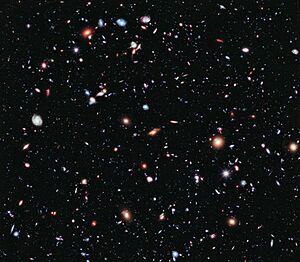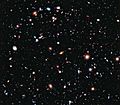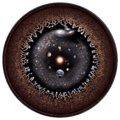Cosmology facts for kids

Cosmology is the study of the universe. It looks at how the universe began, how it has changed over time, and what its future might be. The word "cosmology" comes from Greek words meaning "world" and "study of."
Scientists who study cosmology are often astronomers and physicists. They use scientific methods to understand the universe. Cosmology is different from astronomy. Astronomy focuses on individual objects like stars and planets. Cosmology, however, looks at the entire universe as one big thing.
The term cosmology was first used in English in 1656. It became more widely known in 1731.
Some beliefs about the universe's origin come from mythological or religious stories. This is called religious cosmology. But physical cosmology uses scientific laws and observations to explain the universe.
One important idea in modern physical cosmology is the Big Bang theory. This theory tries to explain how the universe started and grew.
Scientists like David Spergel say cosmology is a "historical science." This is because when we look far out into space, we are actually looking back in time. This happens because light takes a very long time to travel across vast distances.
Contents
Understanding the Universe
Physics and astrophysics are key to understanding the universe. They use scientific observations and experiments. Physical cosmology uses both math and observations to study the whole universe.
Scientists believe the universe began with the Big Bang. This event happened about 13.8 billion years ago. Right after the Big Bang, the universe expanded very quickly. This quick expansion is called cosmic inflation.
The study of how the universe began is called Cosmogony. Mapping the features of the universe is called cosmography.
What is Physical Cosmology?
Physical cosmology is a part of physics and astrophysics. It focuses on the physical start and growth of the universe. It also studies the universe's nature on a very large scale. In the past, this field was known as "celestial mechanics." That was the study of how objects in the heavens move.
Related topics
Images for kids
-
The Hubble eXtreme Deep Field (XDF) shows the farthest galaxies ever photographed. Every speck of light is a galaxy, some as old as 13.2 billion years.
-
This image shows the observable universe on a logarithmic scale.
See also
 In Spanish: Cosmología para niños
In Spanish: Cosmología para niños



